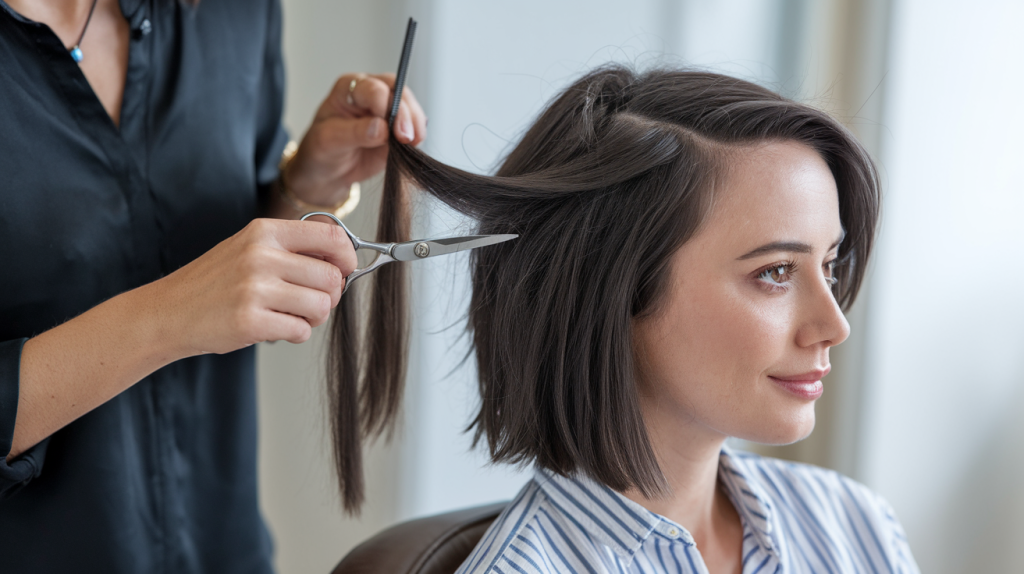Postpartum hair regrowth can be a challenge. New mothers often face this issue.

Learning to style regrowth effectively helps boost confidence. The journey of motherhood brings many changes, including hair loss. After childbirth, many women notice significant hair shedding. This phase, though temporary, can feel overwhelming. Regrowth starts eventually, but it often looks different.
Managing and styling this new hair becomes crucial. Simple techniques can make a big difference. Easy and practical solutions exist to help new mothers feel beautiful. This blog will guide you on how to style postpartum hair regrowth. With helpful tips, you can embrace this new phase. Let’s explore ways to manage and style your regrown hair with ease.
Understanding Postpartum Hair Changes
Understanding postpartum hair changes can help new mothers manage their hair better. After childbirth, many women notice changes in their hair. These changes can be surprising and sometimes frustrating. But knowing what to expect can make this phase easier to handle.
Common Hair Issues
Many new mothers experience hair shedding. This is the most common issue. Hair may fall out in clumps. Your hair may feel thinner. Some women also notice changes in hair texture. Your hair may become more dry or oily. These changes can be temporary.
Why Hair Changes Happen
During pregnancy, hormone levels rise. These hormones help hair grow thicker. After childbirth, hormone levels drop quickly. This causes more hair to enter the shedding phase. This is why you might see more hair falling out. The body needs time to adjust. Over time, your hair growth cycle will normalize.
Nutritional Support
Postpartum hair regrowth can be challenging. Nutritional support is vital for healthy hair. Proper nutrition helps your body recover and promotes stronger hair growth. This section focuses on essential vitamins and dietary recommendations for postpartum hair regrowth.
Essential Vitamins
Vitamins play a key role in hair regrowth. Vitamin A supports scalp health and sebum production. It keeps hair moisturized. Vitamin C is crucial for collagen production. Collagen strengthens hair structure.
Vitamin D helps create new hair follicles. It is essential for hair regrowth. Vitamin E improves blood flow to the scalp. Better circulation encourages hair growth. B vitamins, like B7 (biotin) and B12, boost hair health. They help convert food into energy and support cell growth.
Dietary Recommendations
Eating a balanced diet is important for hair regrowth. Include lean proteins like chicken, fish, and legumes. Proteins are the building blocks of hair. Add leafy greens like spinach and kale. They provide iron and vitamins.
Incorporate nuts and seeds in your diet. They are rich in omega-3 fatty acids. Omega-3s nourish hair follicles and promote growth. Consume fruits like berries and oranges. They are packed with antioxidants and vitamin C. Drink plenty of water. Hydration is key for healthy hair.
Consider taking a prenatal or postnatal supplement. Supplements can fill nutritional gaps. Always consult with a healthcare provider before starting any supplement.
Choosing The Right Hair Products
Postpartum hair regrowth can be a challenging phase. Finding the right hair products is key to managing new hair growth and maintaining healthy locks. Let’s explore the best options for shampoos, conditioners, and styling products.
Shampoos And Conditioners
Selecting the right shampoos and conditioners is crucial for postpartum hair care. Look for products that are gentle on the scalp and nourish your hair.
- Gentle Formulas: Opt for sulfate-free shampoos that cleanse without stripping natural oils.
- Moisturizing Conditioners: Choose conditioners that hydrate and strengthen your hair.
- Ingredients: Look for natural ingredients like aloe vera, coconut oil, and biotin.
A good shampoo and conditioner can help reduce hair breakage and promote healthy growth.
Styling Products
Using the right styling products can make a big difference in managing postpartum hair.
| Product Type | Benefits |
|---|---|
| Volumizing Mousse | Adds body to thin hair. |
| Leave-in Conditioner | Provides extra moisture and detangles hair. |
| Heat Protectant Spray | Protects hair from heat damage. |
Using these products can help you style your hair with ease. They provide extra support and protection for your new hair growth.
Gentle Hair Care Techniques
Postpartum hair regrowth can be challenging. New mothers might feel overwhelmed by the changes in their hair. Gentle hair care techniques can make a significant difference. These techniques will help to care for delicate, regrowing hair. Let’s explore some simple methods to maintain and style postpartum hair.
Washing And Drying Tips
Washing your hair correctly can protect it from damage. Use a sulfate-free shampoo to avoid stripping natural oils. Natural oils are essential for hair health. Wash your hair with lukewarm water. Hot water can dry out your scalp. It can also weaken hair strands.
After washing, avoid rubbing your hair with a towel. Gently pat your hair dry. Rubbing can lead to breakage. Use a microfiber towel for better results. Microfiber towels are gentle on the hair. They help to reduce frizz and breakage.
Brushing And Combing
Brushing and combing are important for hair health. Use a wide-tooth comb to detangle your hair. Start from the ends and work your way up. This method prevents unnecessary tugging and breakage. Be gentle and patient while combing.
Use a soft-bristle brush for daily brushing. A soft-bristle brush is gentle on the scalp. It helps to distribute natural oils evenly. Brush your hair when it is dry. Wet hair is more susceptible to damage. Avoid over-brushing. Over-brushing can lead to split ends and breakage.
Effective Hairstyles For Regrowth
Postpartum hair regrowth can be challenging. Hormonal changes often cause hair loss. Effective hairstyles can help manage and style regrowth. Here are some tips for short and long hairstyles.
Short Hairstyles
Short hairstyles are great for managing postpartum regrowth. They require less maintenance. Here are some popular short hairstyles:
- Pixie Cut: This is a low-maintenance style. It keeps hair off the neck. It also makes thinning hair less noticeable.
- Bob Cut: A bob cut can be chin-length or shorter. It adds volume to thin hair. It is also easy to style.
- Layered Cut: Layers add texture and movement. They can make thin hair look fuller.
Short hairstyles are versatile. They can be styled in different ways. Use a light mousse to add volume. A round brush can help create waves. Regular trims keep the style fresh.
Long Hairstyles
Long hairstyles can also work for postpartum regrowth. They offer more styling options. Here are some popular long hairstyles:
- Loose Waves: Use a curling iron to create waves. This adds volume and texture. It also helps blend new growth with longer strands.
- Ponytail: A high ponytail is chic and easy. It keeps hair out of the face. Use a hair tie that won’t pull on new growth.
- Braids: Braids are a protective style. They keep hair tangle-free. They also hide uneven lengths.
Long hairstyles require more care. Use a wide-tooth comb to avoid breakage. Deep condition your hair weekly. This keeps it healthy and shiny.
Professional Treatments

Postpartum hair regrowth can be challenging. Professional treatments can help. These treatments offer effective solutions for new moms. They nourish hair and encourage healthy growth. Let’s explore some options.
Salon Treatments
Salons offer a variety of treatments for postpartum hair regrowth. Professional stylists can recommend the best options.
- Keratin Treatments: These strengthen hair and reduce breakage. They also add shine.
- Scalp Massages: Massages improve blood flow to the scalp. This can promote hair growth.
- Hair Masks: Deep-conditioning masks nourish and hydrate hair. They help repair damage.
Regular visits to a salon can maintain hair health. Always consult with your stylist for personalized advice.
At-home Treatments
Not everyone has time for salon visits. At-home treatments are convenient and effective.
- Oil Treatments: Use oils like coconut or argan. They nourish the scalp and hair.
- Scalp Exfoliation: Exfoliate your scalp to remove dead skin. This can improve hair growth.
- Hair Serums: Serums protect hair from damage and add moisture.
Consistency is key with at-home treatments. Use these methods regularly for the best results.
Both salon and at-home treatments have their benefits. Choose what fits your schedule and needs. Healthy hair is achievable with the right care.
Managing Hair Loss
Managing hair loss after childbirth can be a challenging experience. Postpartum hair regrowth often comes with its own set of issues. Let’s explore some practical tips to manage hair loss effectively.
Stress Reduction
Stress impacts hair health significantly. New mothers often experience high levels of stress. Reducing stress can help in managing hair loss. Here are some simple tips:
- Practice deep breathing exercises.
- Engage in light physical activities like walking.
- Take short naps whenever possible.
- Consider meditation to calm your mind.
When To See A Doctor
While hair loss is common postpartum, there are times when you should consult a doctor. Here are some signs:
- Excessive hair shedding beyond six months postpartum.
- Bald patches or thinning hair in specific areas.
- Redness or itching on the scalp.
- Hair loss accompanied by other symptoms like fatigue or weight loss.
Your doctor may recommend treatments or supplements to address the issue. Early consultation can help in managing the problem effectively.
Real-life Success Stories

Postpartum hair regrowth can be a challenging journey. Many new moms face hair loss after giving birth. But, with patience and the right tips, it’s possible to regain your hair. Let’s explore some real-life success stories. These stories will inspire you and show that you’re not alone.
Mom Experiences
Many moms have shared their hair regrowth journeys. They have tried different methods and products. Here are some experiences:
- Alice: She used natural oils and saw significant improvement.
- Maria: She followed a balanced diet and noticed less hair fall.
- Sophia: She opted for regular scalp massages and saw new hair growth.
These moms found what worked best for them. It might take some trial and error. But their stories offer hope and practical tips.
Frequently Asked Questions
How Can I Manage Postpartum Hair Regrowth?
Postpartum hair regrowth can be managed by using gentle hair care products. Avoid excessive heat styling and opt for nourishing treatments. Trim regularly to maintain healthy ends.
What Hairstyles Are Best For Postpartum Hair?
Simple, low-maintenance hairstyles like loose buns, braids, and ponytails are ideal. These styles minimize stress on fragile, regrowing hair.
Can Diet Impact Postpartum Hair Regrowth?
Yes, a balanced diet rich in vitamins and minerals supports healthy hair regrowth. Include foods high in biotin, zinc, and omega-3 fatty acids.
How Often Should I Wash Postpartum Hair?
Wash your hair two to three times a week. Use a mild shampoo and conditioner to maintain natural oils and prevent dryness.
Conclusion
Embrace your postpartum hair journey with patience and care. Experiment with gentle hairstyles. Use nourishing products to promote healthy growth. Stay consistent with your hair care routine. Celebrate small progress and remember, regrowth takes time. Be kind to yourself. Each step brings you closer to your hair goals.
Enjoy this new chapter of motherhood. Your hair will thrive with the right attention. Stay confident and beautiful.

